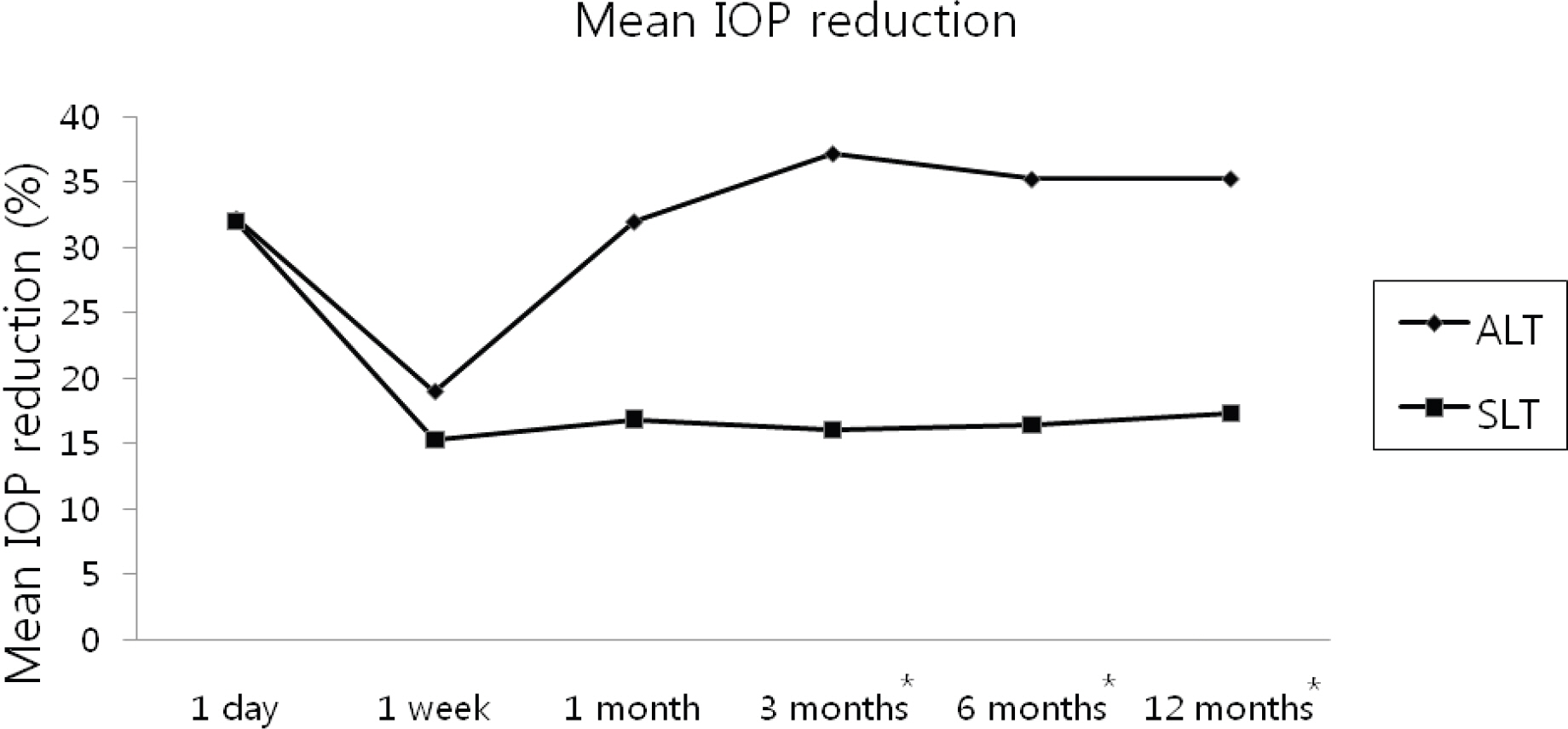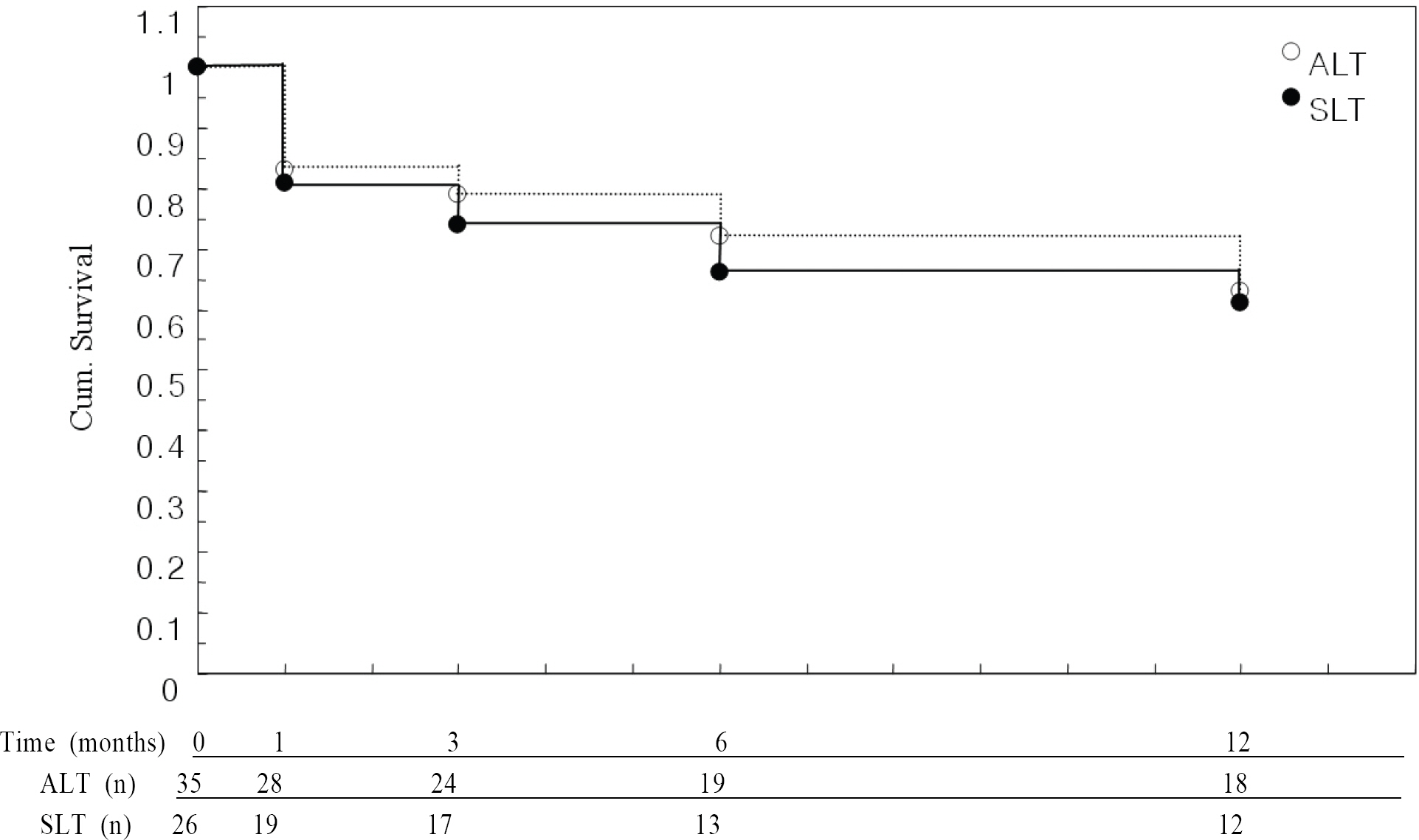J Korean Ophthalmol Soc.
2008 Sep;49(9):1491-1500.
Comparison of Clinical Outcomes of Argon Laser Versus Selective Laser Trabeculoplasty in POAG
- Affiliations
-
- 1Cheil Eye Hospital, Daegu, Korea. jjparkmd@nate.com
Abstract
- PURPOSE
To compare the clinical outcomes between patients undergoing argon laser trabeculoplasty (ALT) and those undergoing selective laser trabeculoplasty (SLT).
METHODS
Sixty-one eyes of 61 patients with primary open-angle glaucoma who were treated with more than 1 kind of antiglaucoma medication eye drop were enrolled in this study. Thirty-five eyes of 35 patients were treated with argon laser trabeculoplasty (ALT). Twenty-six eyes of 26 patients were treated with selective laser trabeculoplasty (SLT). The mean IOP at 1, 3, 6, and 12 months and the success rate of treatment at the 12-month follow-up period were evaluated in all patients.
RESULTS
At 12 months postoperative, the ALT group had a mean IOP of 16.53+/-2.58 mmHg with a mean IOP reduction of 35.27%, while the SLT group had a mean IOP of 18.40+/-5.61 mmHg with a mean IOP reduction of 17.37%. The success rates of treatment defined as definition 1 were 62.85% in ALT and 62.50% in SLT, and the success rates defined as definition 2 were 51.42% in ALT and 46.15% in SLT.
CONCLUSIONS
There were no significant differences in the IOP lowering effect or success rates between the ALT and SLT patients at 12 months postoperatively.
Keyword
Figure
Reference
-
References
1. Wise JB, Witter SL. Argon laser therapy for open-angle glaucoma. A pilot study. Arch Ophthalmol. 1979; 97:319–22.2. Latina MA, Park C. Selective targeting of trabecular meshwork cells: in vitro studies of pulsed and CW laser interactions. Exp Eye Res. 1995; 60:359–71.
Article3. Latina MA, Sibayan SA, Shin DH. . Q-switched 532-nm Nd:YAG laser trabeculoplasty (selective laser trabeculoplasty): a multicenter, pilot, clinical study. Ophthalmology. 1998; 105:2082–8.4. Noecker RJ, Kramer TR, Latina M. . Comparison of acute morphologic changes after selective laser trabeculoplasty and argon laser trabeculoplasty by electron microscopic evaluation. Invest Ophthalmol Vis Sci. 1998; 39:472–3.5. Song J, Lee PP, Epstein DL. . High failure rate associated with 180 degrees selective laser trabeculoplasty. J Glaucoma. 2005; 14:400–8.
Article6. Lee HS, Baek NH, Moon JI. Comparison of short-term outcomes of argon laser versus selective laser trabeculoplasty in open-angle glaucoma. J Korean Ophthalmol Soc. 2005; 46:2004–9.7. Wise JB. Glaucoma treatment by trabecluar tightening with argon laser. Int ophthalmol Clin. 1981; 21:69–78.8. Kramer TR, Noecker RJ. Comparison of the morphologic changes after selective laser trabeculoplasty and argon laser trabeculoplasty in human eye bank eyes. Ophthalmology. 2001; 108:773–9.
Article9. Kim JS, Lee YG, Hong YJ. Institute of Vision Reseach, Q-switched frequency doubled Nd:YAG laser trabeculeoplasty. J Korean Ophthalmol Soc. 1999; 40:2591–6.10. Kim YJ, Moon CS. One-year follow-up of laser trabeculoplasty using Q-switched frequency-doubled Nd:YAG laser 523 nm wavelength. Ophthalmic Surg Lasers. 2000; 31:394–9.11. Damji KF, Shah KC, Rock WJ. . Selective laser trabeculoplasty versus argon laser trabeculoplasty: a prospective randomized clinical trial. Br J Ophthalmol. 1999; 83:718–22.12. Tuulonen AN, Airaksinen J, Kuulosmaa K. Factors influencing the outcome of laser trabeculoplasty. Am J ophthalmol. 1985; 99:388–91.
Article13. Thomas JV, El-Moffy T, Hamdy EE, Simmons RJ. Argon laser trabeculoplasty as initial therapy for glaucoma. Arch Ophthalmol. 1984; 102:702–3.
Article14. Yoon HS, Oum BS. Clinical result of argon laser trabeculoplasty in open angle glaucoma. J Korean Ophthalmol Soc. 1986; 27:179–85.15. Damji KF, Bovell AM, Hodge WG. . Selective laser trabeculoplasty versus argon laser trabeculoplasty: results from a 1 year randomized clinical trial. Br J Ophthalmol. 2006; 90:1490–4.16. Harasymowycz, Papamatheakis DG, Latina M. . Selective laser trabeculoplasty complicated by intraocular pressure elevation in eyes with heavily pigmented trabecular meshworks. Am J Ophthalmol. 2005; 139:1110–3.
- Full Text Links
- Actions
-
Cited
- CITED
-
- Close
- Share
- Similar articles
-
- Comparison of Short-term Outcomes of Argon Laser versus Selective Laser Trabeculoplasty in Open-Angle Glaucoma
- The Effect of 1 % Apraclnidine on Intraocular Pressure Following Argon Laser Iridotomy and Laser Trabeculoplasty
- Short-Term Clinical Outcomes of Laser Trabeculoplasty Using a 577-nm Wavelength Laser
- Comparison of Photocoagulation with the Argon and Diode Laser in Rabbit Eyes
- Changes in the Rate of Flow by Quantitative Analysis of Aqueous Humor after Argon Laser Trabeculoplasty in Rabbits




